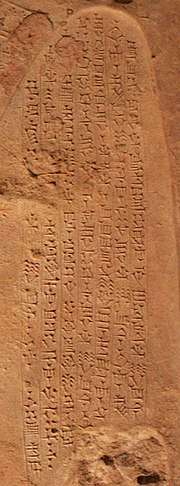Shutruk-Nakhunte
Šutruk-Nakhunte was king of Elam from about 1184 to 1155 BC (middle chronology), and the second king of the Shutrukid Dynasty.

Elam amassed an empire that included most of Mesopotamia and western Iran. Under his command, Elam defeated the Kassites and established the short-lived Elamite Empire, conquered within about 40 years by Nebuchadnezzar I of Babylon, in 1120 BC.
Šutruk-Nakhunte was married to the daughter of a Kassite king named Meli-Šipak.
Inscription on the Naram-Sin victory stele

Shutruk-Nahhunte is known by an inscription to have taken the Victory Stele of Naram-Sin, dated about one millennium earlier to circa 2250 BC. His inscription appears on the top right corner of the stele, on the depiction of a mountainous cone, and was written in Elamite by Shutruk-Nahhunte himself:[2]
"I am Shutruk-Nahhunte, son of Hallutush-Inshushinak, beloved servant of the god Inshushinak, king of Anshan and Susa, who has enlarged the kingdom, who takes care of the lands of Elam, the lord of the land of Elam. When the god Inshushinak gave me the order, I defeated Sippar. I took the stele of Naram-Sin and carried it off, bringing it to the land of Elam. For Inshushinak, my god, I set it as an offering."
In popular culture
Shutruk-Nakhunte gained a small public exposition in Ethan Canin's short story "The Palace Thief", and its adaptation in the 2002 film The Emperor's Club, in which one of the key elements is a plaque describing the exploits of Shutruk-Nakhunte, described as a once famous egomaniacal conqueror virtually unknown today.
The quote from the film is, "'I am Shutruk Nahunte, King of Anšhan and Susa, Sovereign of the land of Elam. I destroyed Sippar, Took the Stele of Niran-Sin, and brought it back to Elam, where I erected it as an offering to my god.' — Šutruk-Nahunte, 1158 B.C."
The plaque hanging on the wall of the film reads...
'I am Shutruk Nahunte, King of Anšhan and Susa, Sovereign of the land of Elam. By the command of Inshushinak I destroyed Sippar, Took the Stele of Niran-Sin, and brought it back to Elam, where I erected it as an offering to my god, Inshushhinak.' — Šutruk-Nahunte, 1158 B.C.’
Sources
- Harper, Prudence O. (1992). Royal City of Susa: Ancient Near Eastern Treasures in the Louvre. Metropolitan Museum of Art. pp. 181-182.
- Mieroop, Marc Van De (2015). A History of the Ancient Near East, ca. 3000-323 BC. John Wiley & Sons. p. 199. ISBN 9781118718230.
- D.T. Potts: The Archaeology of Elam, Cambridge University Press, Cambridge 1999, 232-237
| Preceded by Khallutush-Inshushinak |
King of Elam 1184–1155 BC |
Succeeded by Kutir-Nahhunte III |